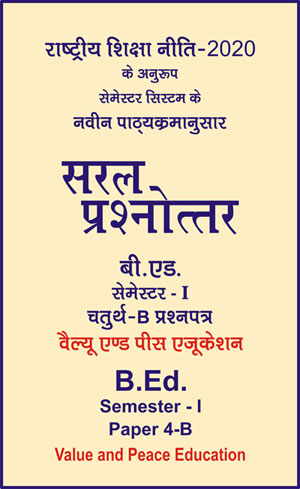|
बी एड - एम एड >> बी.एड. सेमेस्टर-1 प्रश्नपत्र-IV-B - वैल्यू एण्ड पीस एजुकेशन बी.एड. सेमेस्टर-1 प्रश्नपत्र-IV-B - वैल्यू एण्ड पीस एजुकेशनसरल प्रश्नोत्तर समूह
|
5 पाठक हैं |
||||||
बी.एड. सेमेस्टर-1 प्रश्नपत्र-IV-B - वैल्यू एण्ड पीस एजुकेशन (अंग्रेजी भाषा में)
Question- Give various Features of Value or Moral Conflict.
Answer -
Features of Moral Conflict
To further understand moral conflict and deal with it effectively, it is helpful to be aware of its common features.
Misunderstandings
The first general feature is the tendency for each side to misunderstand the words and actions of the other. People from incommensurate traditions may have trouble communicating because they rely on different systems of meaning, norms of communication, and behavioral expectations.
One possibility is that the participants use the same vocabulary but define and use these key terms differently. For example, the word “honor” might mean material excellence to one party and economic success to the other. But it is also possible that the groups simply rely on radically different vocabularies that stress the importance of different values. If one party regards the key terms used by the other as unimportant, communication between them will be quite strained. All of this contributes to misunderstanding and makes it very difficult for participants to “articulate the logic of the other sides’ social world in ways that the other side will accept.”
Further misunderstanding and erroneous perceptions may arise because groups often perceive, define, and deal with conflict in different ways. Because of differing cultural frames, many of the words used to describe appropriate behavior during conflict do not reflect the same content from one culture to another. For example, the terms “conflict,” “aggression,” “peace,” “time,” and “negotiation” are not value-free. They carry judgments with them and may be used differently in different cultures. Aggression, usually defined as intentionally hurting another person, is a reflection of norms of conduct, and what hurts in one society may not be what hurts in another society. Thus, indicators of aggression may vary. In the Middle East, for example, a direct refusal is considered a hostile gesture. But in other cultures, raising an objection is customary and well accepted. Ideas about fairness and images of justice can also vary among different groups.
Mistrust
The second general feature of moral conflict is that group members tend to develop feelings of mistrust and suspicion toward the other group - even a sense that the other group poses a danger to their very survival. Given the groups' different values and systems of meaning, actions taken by one side to defuse or resolve the conflict may often be perceived as threatening by the other party. This second party is likely to be stunned and offended by the other's action, and to respond in a negative way. This serves to perpetuate and/or intensify the conflict. Thus, the groups' different conceptions of morality lead to misunderstanding, which in turn contributes to conflict escalation.
Strained and Hostile Communication
Another general feature of moral conflicts is the hostility characteristic of the relationship and the communication between the parties. While sophisticated rhetoric consists of exchanging reasons in a quest to form shared beliefs, the patterns of communication in moral conflicts consist primarily in personal attacks, denunciations, and curses. Slogans and chants replace arguments intended to persuade and inform, and the discourse between the two groups involves many statements about what is wrong with the other group. Thus, opportunities for opposing groups to converse intelligibly and reason together are diminished. When one group is denounced, its members are likely to become defensive, which can contribute to more negative emotions and behavior.
Thus, discourse often moves to sweeping generalizations and abstract principles. For example, groups may appeal to abstract ideals of religion, patriotism, liberty, or “what America is all about” to point out why the actions of another group are morally wrong. In many cases, groups rely on rigidly held social or political beliefs, or ideology, to indicate why their position is morally superior. Such ideology is often accompanied by a sense of urgency about the need for pursuing those ideals.
Negative Stereotyping
Discourse often involves sweeping generalizations about members of the other group. People in moral conflicts tend to invidiously categorize and denounce the personalities, intelligence, and social manners of those with whom they disagree. They may form negative stereotypes and attribute moral depravity or other negative characteristics to those who violate their cultural expectations, while they ignore their own vices and foibles, perceiving their own group to be entirely virtuous. This is what social psychologists call the attribution error.
For example, disputants may attribute the “strange” behavior of foreigners to undesirable character traits, such as moral depravity or lack of intelligence, rather than realizing that their seemingly inappropriate acts are simply a matter of cultural difference. Because parties are typically unable to give rich accounts of the moral order of the opposing group, they are likely to attribute whatever the group does to its stupidity, evil nature, and overall moral depravity. Groups with radically different conceptions of morality may feel stunned and offended by the actions or words of the other group and denounce those actions or the group as a whole.
Non-negotiability
These belief systems pull together fundamental assumptions and global viewpoints that are in general not up for compromise. Strict adherence to ideology can make it particularly difficult for individuals to approach those with differing world views with an open mind. They come to see the conflict entirely in win-lose terms. They may even get to the point that the goal of harming the other becomes more important than helping oneself.
|
|||||













